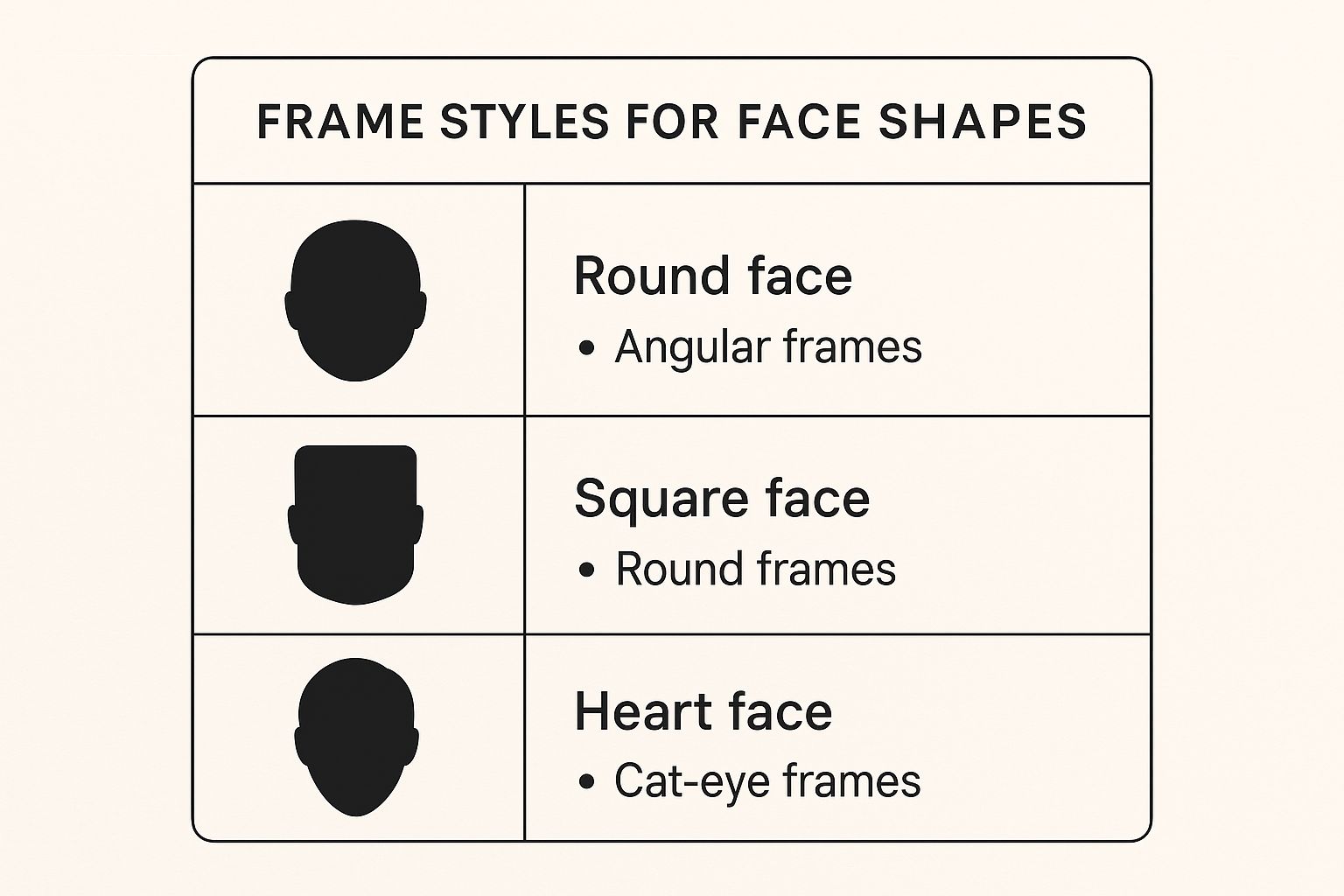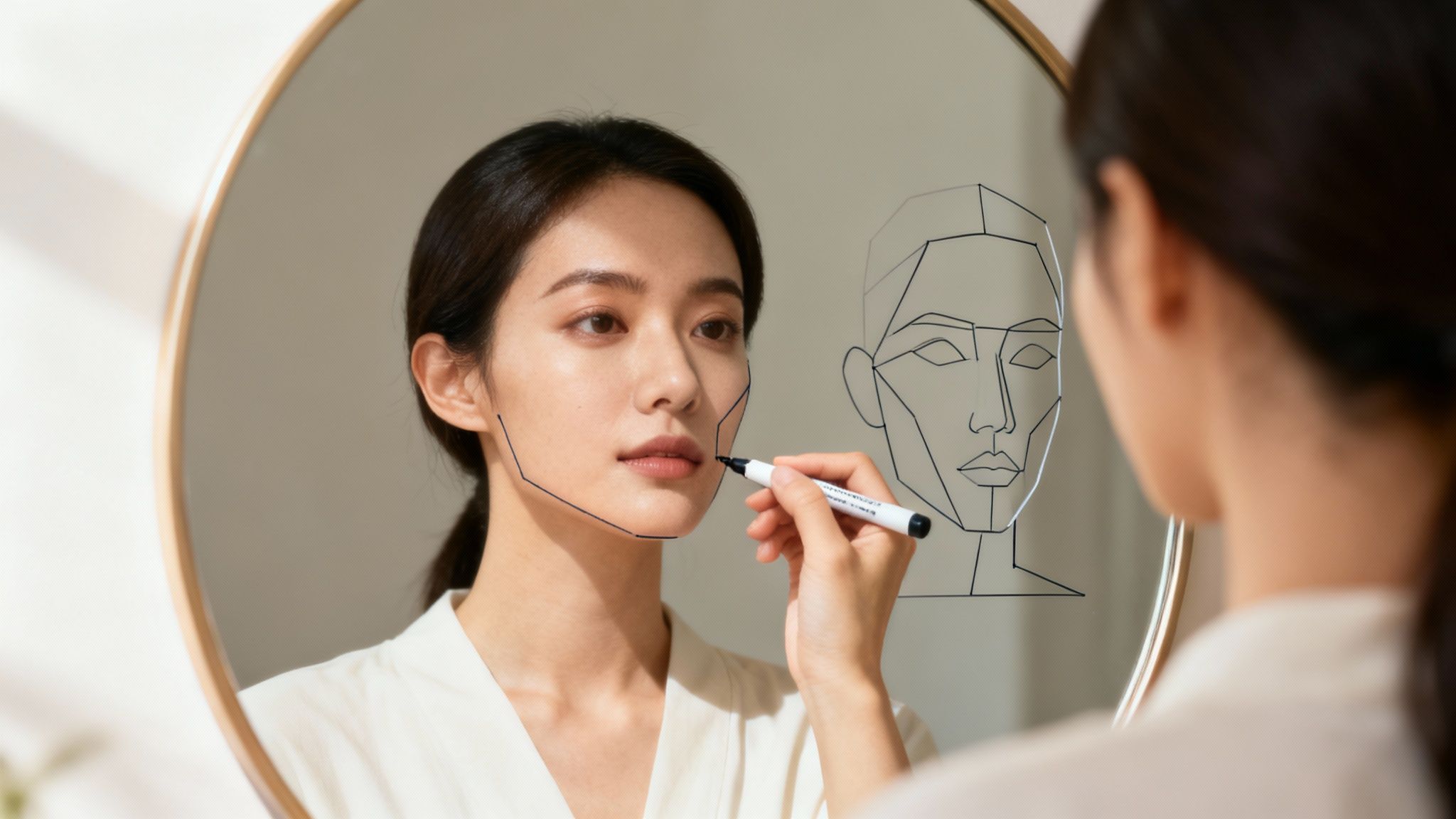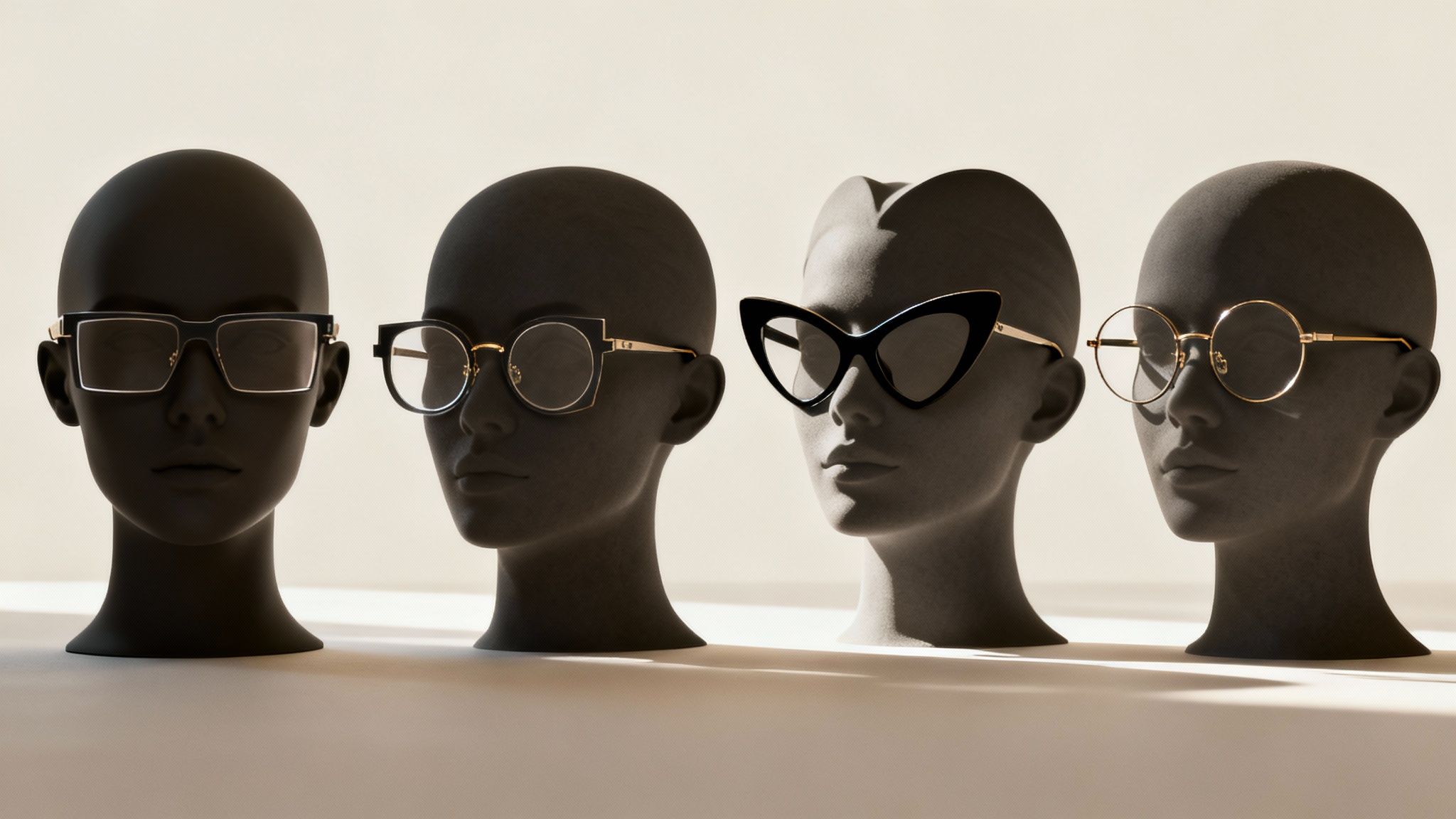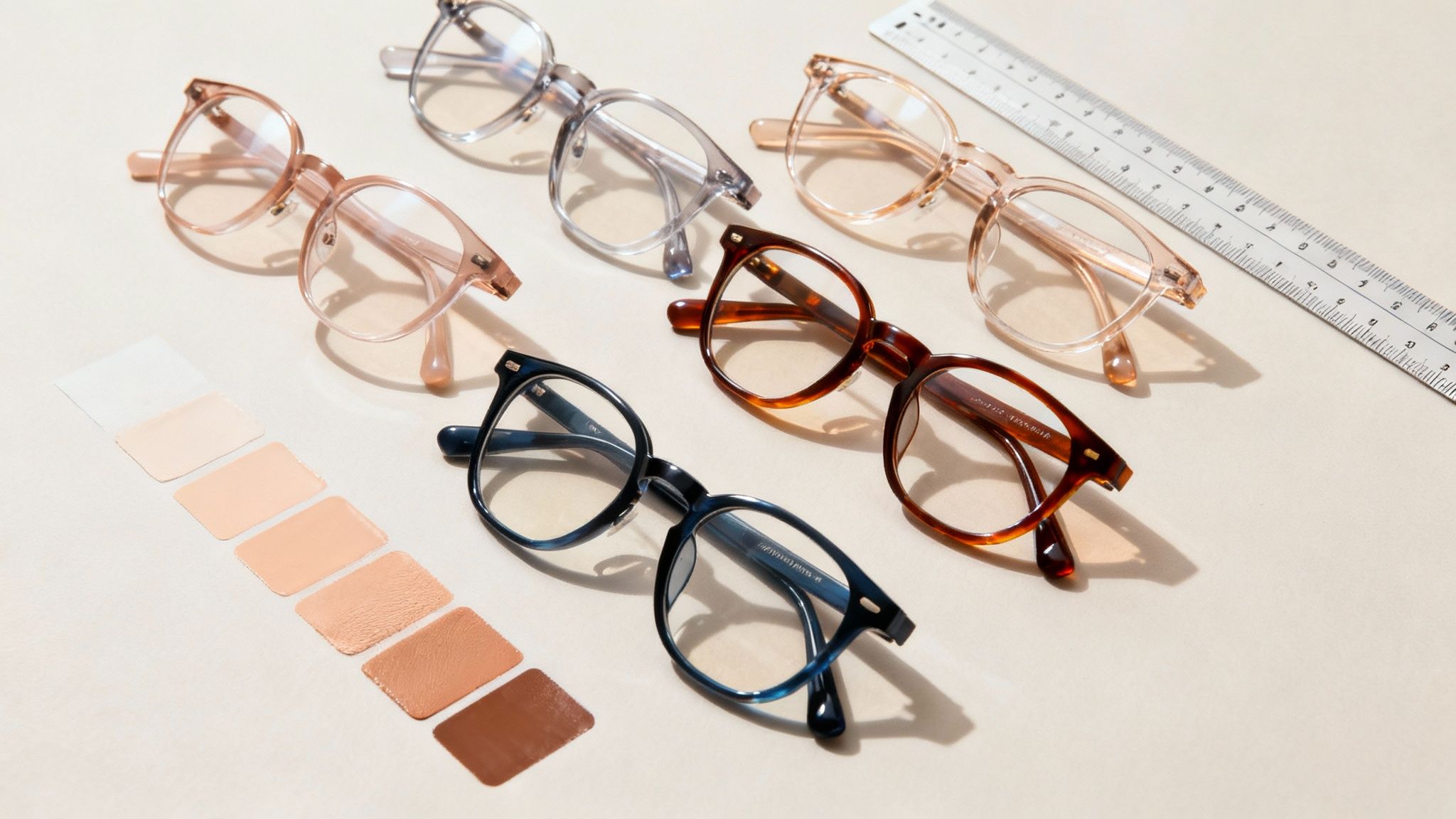
What Glasses Suit My Face? A Practical Guide
Finding the right glasses for your face shape is surprisingly straightforward. The secret? It's all about contrast. The whole idea is to pick a frame shape that offsets your face shape, creating a natural sense of balance.
If you have a softer, more curved face, you'll likely look fantastic in sharp, angular frames. On the flip side, if your face has more distinct angles, softer and rounder styles will complement you perfectly. Think of it as a simple case of opposites attracting.
Why Contrast Is Your Best Friend in Eyewear
Picture your face as a canvas. Your glasses are the frame meant to highlight your best features, not compete with them. Just like an artist wouldn't put a loud, ornate frame on an already busy painting, you don't want your glasses to overwhelm your natural features. The goal is a harmonious balance that looks intentional and feels right.
This principle of contrast is the foundation for almost every good recommendation you'll ever get. When you choose a frame that adds an element your face shape is missing—like adding angles to a round face or curves to a square one—you create a look that's both visually pleasing and comfortable.
A Quick Look at Perfect Pairings
Getting this concept down is the first big step. To make it even easier, here’s a quick visual guide that pairs common face shapes with their most flattering frame styles.

This visual really drives home the idea that creating a little opposition between your face and frame is the key to a great fit.
Of course, the shape is just one piece of the puzzle. Things like frame size, color, and even the kind of lenses you need are just as important. For instance, if you’re like most of us and spend a lot of time on digital devices, a stylish frame is only half the battle. You’ll also want lenses that protect your eyes from digital strain.
That's where blue light glasses, like the high-quality options from PROSPEK, become so important. They fuse protective technology with modern designs, so you never have to choose between style and comfort.
Remember, these are guidelines, not unbreakable rules. The single most important thing is finding a pair you absolutely love and feel confident wearing. This guide is just here to give you the knowledge to explore different styles and find your perfect match.
Face Shape and Frame Styles at a Glance
For a quick reference, this table breaks down which frame styles create the most flattering balance for your face shape. It's a great starting point for your search.
| Face Shape | Key Characteristics | Best Frame Styles | Styles to Approach with Caution |
|---|---|---|---|
| Round | Soft curves, full cheeks, similar width and length | Square, rectangular, geometric, cat-eye | Small or perfectly round frames |
| Square | Strong jawline, broad forehead, angular features | Round, oval, aviator, thin metal frames | Boxy or heavy geometric frames |
| Oval | Balanced proportions, slightly curved jawline | Almost any style! Square, rectangular, cat-eye | Overly large frames that disrupt balance |
| Heart | Broader forehead, high cheekbones, narrow chin | Round, oval, bottom-heavy frames, rimless styles | Top-heavy or heavily embellished frames |
| Diamond | Narrow forehead and jaw, wide cheekbones | Oval, cat-eye, browline, rimless frames | Narrow or small frames |
Use this as a cheat sheet, but don't be afraid to experiment. Sometimes the pair you least expect is the one that looks the best.
How to Identify Your Face Shape in Under a Minute

Before you can confidently answer, "What glasses suit my face?" you need a starting point: your face shape. Forget about complicated rulers and measuring tapes. The easiest way to figure this out is with a mirror and something easy to wipe off, like a dry-erase marker or even a bar of soap.
It's a surprisingly simple method that reveals your facial geometry in seconds.
First, pull your hair back so your entire face is visible. Stand directly in front of a mirror, hold your head still, and carefully trace the outline of your face right onto the glass. Don't worry about making it perfect—you're just capturing the basic shape. Step back, and the outline on the mirror gives you a clear, honest look at your facial structure.
Analyzing Your Facial Outline
With your outline ready, it's time to play detective. Take a good look at the shape you’ve drawn and ask yourself a few key questions. These simple observations are all you need.
- What's the widest part? Is it your forehead, your cheekbones, or your jaw? This is one of the biggest clues.
- What's the shape of your jaw? Is it soft and rounded, or is it sharp and angular?
- What’s the overall length and width? Does your face seem about as long as it is wide, or is it noticeably longer?
Answering these will help you narrow things down. For instance, a face that's equally long and wide with a soft jaw is likely round. An equally proportioned face with a strong, angular jaw is probably square.
Identifying your face shape isn't about fitting into a perfect box. It's about understanding your unique features so you can choose frames that create balance and highlight what you love.
Breaking Down the Primary Shapes
Now, let's connect your observations to the most common face shapes. See which description below best matches the outline staring back at you from the mirror.
Common Face Shape Characteristics:
- Oval: Your face is longer than it is wide, with a softly rounded jawline and forehead. Your cheekbones are typically the widest point, which creates a very balanced silhouette.
- Square: Your forehead, cheekbones, and jaw are all roughly the same width. You have a strong, defined jawline that gives your face a distinctly angular look.
- Round: Your face is about as wide as it is long, with soft curves and often fuller cheeks. You won't see any sharp angles along your jawline or hairline.
- Heart: You have a broader forehead and prominent cheekbones that taper down to a narrower, more delicate chin. Think of an inverted triangle.
- Diamond: Your cheekbones are the star of the show—they’re the widest part of your face, while your forehead and jawline are narrower and more defined.
Once you’ve identified your shape, you have the key piece of the puzzle. Now you’re ready to find frames that not only fit but truly flatter your features.
Matching Frames to Your Unique Face Shape

Alright, you've figured out your face shape. Now for the really fun part—finding frames that not only fit but make you feel fantastic. The golden rule here is all about creating balance through contrast. We’re not trying to hide your features, but to highlight them with a bit of style and intention.
Think of it this way: if your face has softer, rounded lines, frames with sharper angles will introduce some welcome definition. On the flip side, if your face is more angular, frames with gentle curves can bring in a softening effect. This simple game of opposites is the secret to confidently answering the age-old question, "What glasses suit my face?"
This isn't just a style theory, either. A 2018 survey found that over 60% of glasses wearers actually prefer frames that contrast with their face shape. It's a common sight: people with round faces gravitating toward angular frames, and those with square faces picking out softer, more rounded styles. It just works.
Glasses for a Round Face
A round face is all about soft curves, full cheeks, and a width and length that are nearly identical. There aren't any sharp angles, giving you a gentle, approachable look. The goal with frames is to add a bit of structure and create the illusion of a longer, more defined face.
To pull this off, you’ll want to look for frames with strong, angular lines.
- Rectangular Frames: These are perfect. They add sharp, clean lines that cut through the softness of a round face, creating a more chiseled silhouette.
- Square Frames: Much like rectangular styles, square glasses provide a bold contrast that helps to balance out your facial proportions.
- Cat-Eye Frames: The upswept corners of a cat-eye are brilliant for drawing the eye upward, which helps elongate the face and put a spotlight on your cheekbones.
Glasses for a Square Face
A square face is defined by its strong, angular features, like a broad forehead and a prominent jawline. The face is about as wide as it is long, giving it a powerful, structured appearance. The best glasses for you will soften these angles and introduce some gentle curves.
Frames with soft, rounded edges are your go-to.
- Round Frames: This is the ultimate contrast for a square face. Round glasses directly soften a strong jawline and other angular features.
- Oval Frames: A slightly more subtle option, oval frames introduce curves without being as bold as perfectly round styles.
- Aviator Frames: With their curved bottom and straight top bar, aviators strike a fantastic balance that perfectly complements a square face.
Glasses for an Oval Face
Often called the "universal" shape, an oval face is longer than it is wide, with balanced proportions and a softly rounded chin and forehead. Because of this natural balance, people with oval faces can pull off a huge variety of frame styles.
The main thing to remember is maintaining that natural harmony. You want to avoid frames that are too overwhelming.
Expert Tip: For oval faces, it all comes down to proportion. The primary rule is to pick frames that are as wide as (or just a little wider than) the broadest part of your face. Steer clear of styles that are too narrow or way oversized, as they can throw off your natural symmetry.
Glasses for a Heart-Shaped Face
A heart-shaped face is wider at the forehead and tapers down to a narrower, sometimes pointed chin. You might also have high, prominent cheekbones. The mission here is to balance the wider top half of your face with the narrower bottom half.
Look for frames that are wider at the bottom or have delicate, understated details.
- Bottom-Heavy Frames: Styles that have more visual weight on the lower rim are great for drawing attention downward, which helps balance out a wider forehead.
- Round or Oval Frames: Soft, curved shapes can beautifully soften the angles of a narrower chin.
- Rimless or Light-Colored Frames: These are excellent for preventing the top of your face from looking too heavy, keeping everything light and airy. And if your face is on the smaller side, getting the proportions just right is crucial. For more tips, you can check out our guide on the best glasses for small faces.
Looking Beyond Face Shape to Find Your Perfect Pair

While figuring out your face shape is a fantastic starting point, it's not the whole story. To really nail the perfect pair, you have to look at the little details that take a good fit and make it a great one. Think of face shape as the foundation—now it's time to add the finishing touches that bring the look together.
The first thing to dial in is frame size. It's all about proportion. Your glasses should be in scale with your face, not overpowering it or getting lost. Frames that are too wide can make your face look narrower than it is, while frames that are too small can make it seem larger. The sweet spot is a size where the frames are just a touch wider than your temples, giving you a balanced and comfortable fit.
Finding Harmony with Color
Color is where you get to let your personality shine. The right frame color can light up your eyes, compliment your hair, and bring out the best in your skin tone. It all comes down to understanding your undertones—are you cool, warm, or neutral?
- Warm Skin Tones: If your skin has yellow, peach, or golden undertones, you'll look incredible in earthy colors. Think tortoise, gold, honey, olive green, and warm reds.
- Cool Skin Tones: For skin with hints of pink or blue, jewel tones and cooler shades are your best friends. Check out frames in silver, black, blue, dark tortoise, and purple.
- Neutral Skin Tones: If you have a mix of both, you're in luck! You can pull off a huge range of colors, from warm, earthy shades to cool jewel tones.
Don't forget to factor in your eye and hair color, too. A frame that picks up on the subtle flecks in your eyes or complements your hair creates a really polished, cohesive look. Even your makeup can play a part; for some great ideas, check out these makeup tips for glasses wearers.
Matching Your Frames to Your Lifestyle
Your glasses need to work for your life, not against it. Are you an athlete who needs something tough and secure that won't fly off during a workout? Or do you work in a professional setting where a sophisticated, classic style is the better call?
The best eyewear slips seamlessly into your daily routine. This means thinking about both the style of the frame and the function of the lenses, especially for anyone who spends a lot of time in front of a screen.
Let's be real, hours spent staring at computers and phones are a daily reality for most of us. This is where lens technology becomes just as critical as frame style. All that exposure to blue light from screens can lead to digital eye strain, headaches, and messed-up sleep patterns.
That's why picking glasses with blue light filtering is a must in the modern world. Brands like PROSPEK offer stylish frames with high-quality lenses built to block that harmful blue light. With PROSPEK glasses, you never have to choose between your personal style and your eye health.
While face shape gets you most of the way there, finding your perfect pair is also about your personal style and how you present yourself. To round out your look, exploring other essential grooming tips can make a huge difference.
How to Shop for Glasses in the Digital Age
Shopping for glasses isn't what it used to be. The days of being stuck with whatever few styles your local shop had on the shelf are long gone. Now, you have a whole world of eyewear at your fingertips.
The old-school optician still has its charm, of course. There’s something to be said for the hands-on experience of feeling the weight of the frames and seeing them on your face right then and there. But online shopping offers a level of variety and convenience that's impossible to beat, letting you browse thousands of styles without leaving your couch. The only hiccup? That nagging uncertainty of how a pair will actually look on you.
The Rise of Virtual Try-On Tools
This is where today’s tech really shines. Augmented reality (AR) virtual try-on tools have completely changed the game, bridging the gap between browsing online and buying with confidence. These tools use your phone or computer's camera to create a live, 3D model of your face, letting you see exactly how different frames will sit from every angle. It’s like having a magic mirror that knows all the rules of fit and proportion we've been talking about.
This technology is fundamentally reshaping how we answer the question, "what glasses suit my face?" Between 2020 and 2025, the use of AI and AR for virtual try-ons has exploded by over 200% among major online eyewear sellers. These smart platforms analyze your facial metrics—like the distance between your eyes or the angle of your jawline—to suggest frames that are practically guaranteed to flatter your features. It's expected that by 2025, at least 35% of all digital eyewear sales will involve some kind of virtual fitting.
Making an Informed Online Choice
Even with these incredible tools, getting your measurements right is still non-negotiable for a perfect fit. A frame that’s too wide or too narrow can throw off your whole look, no matter how stylish it is. Knowing your numbers is the key to turning a great virtual try-on into a comfortable, real-world pair you’ll love to wear. To get started, check out our guide on how to measure eyeglass frames.
When you're shopping online, it's easy to get caught up in style, but don't forget about the lenses. For anyone who clocks serious screen time, choosing computer glasses with blue light filtering isn't just a feature—it's essential for protecting your eyes.
Brands like PROSPEK are built around this idea, offering stylish frames that come standard with superior blue light blocking lenses. This means you don't have to compromise. You can find a pair that perfectly complements your face shape and protects your vision from digital eye strain. It’s this combination of style, technology, and protection that empowers you to make a truly smart choice in today's eyewear market.
Common Questions Before You Buy Your Next Pair
Even with a solid guide, a few questions always seem to pop up right when you’re ready to pull the trigger on a new pair. Getting those last few doubts cleared up can be the difference between buying glasses you simply like and finding a pair you absolutely love.
Let's walk through some of the most common questions to give you that final boost of confidence. Remember, finding the right frames isn’t about one single factor; it’s about how all the pieces—your face shape, hair, and personal style—create a look that feels completely you.
How Does My Hairstyle Affect My Choice of Glasses?
Your hairstyle is like a second frame for your face, so it definitely has a say in which glasses will look best. Think of your hair and frames as a team working to create a balanced look. For example, a style with a lot of volume can add width to your face, which might change the ideal size or shape of frame you're looking for.
Likewise, bangs can visually shorten your forehead, shifting the proportions of an oblong or oval face. The best advice here is simple: try on new frames with your typical, everyday hairstyle. This gives you the most honest preview of how they’ll fit into your daily life and ensures they work with your overall aesthetic, not against it.
What If My Face Is a Mix of Different Shapes?
It's actually incredibly rare for someone's face to fit perfectly into one category. Most of us are a blend of features—maybe you have the high cheekbones of a diamond shape but the softer jaw of a round one. Don't get hung up on this; it just means you have more styles to play with.
The trick is to identify your most prominent feature and pick frames that balance it out. If you have a strong, angular jaw, try frames with softer curves to add a nice contrast. If your forehead is wider, look for glasses with more detail on the bottom rim to draw the eye downward. Use the guidelines as a starting point, not a strict set of rules.
Are There Any Glasses Styles That Look Good on Everyone?
While no single style is a guaranteed winner for every person on the planet, some shapes are famously versatile. Classic aviators, with their top-heavy design and gentle curves, tend to flatter a huge range of face shapes. A simple rectangular frame with slightly softened edges is another safe—and always stylish—bet.
The most "universal" rule isn't really about a specific shape, but about proper proportion. A frame that fits your face correctly—not too wide or too narrow, and sitting comfortably on your nose—will almost always look better than a trendy style that's the wrong size. When in doubt, prioritize fit above all else.
Ultimately, figuring out "what glasses suit my face" is all about finding that sweet spot between time-tested principles and your own unique taste.
For a wide selection of frames that blend timeless style with modern protection, check out Spektrum Glasses. Whether you need powerful blue light filtering for your screen time or just a fresh new look, you can find the perfect fit at https://www.spektrumglasses.com.
